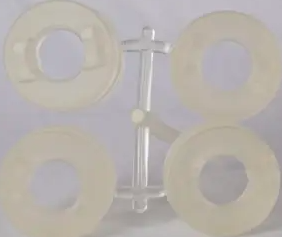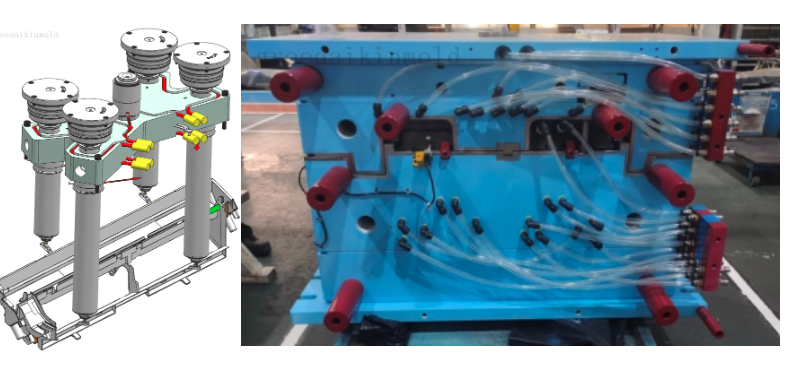Views: 0 Author: Site Editor Publish Time: 2025-07-10 Origin: Site
Injection mold is a complex manufacturing process that relies on precise machinery, tooling, and materials. Whether you’re a product designer, engineer, or procurement specialist, understanding the key terminology used in the injection molding industry is essential for effective communication and decision-making. This guide breaks down the most commonly used terms across machine operation, mold design, material science, and molding processes.

Automatic Mode
A fully automated cycle where the machine completes injection, cooling, and part ejection without manual input.
This mode is ideal for high-volume production and ensures consistent cycle times.
It reduces labor costs and improves process repeatability.
Semi-Automatic Mode
The machine completes one full cycle and then pauses for operator intervention.
This is often used for low-volume runs or when manual part removal is necessary.
It offers more control but requires more human involvement.
Barrel and Screw
The barrel houses the screw, which melts and conveys plastic material through heat and mechanical shear.
The screw design and barrel size determine the machine’s shot capacity and plasticizing efficiency.
These components are critical for achieving uniform melt temperature and pressure.
Nozzle
The nozzle connects the barrel to the mold and directs molten plastic into the sprue.
Different nozzle tips are used depending on material type and mold design.
A properly fitted nozzle prevents leakage and ensures smooth material flow.
Tonnage
Refers to the clamping force the machine can apply to keep the mold closed during injection.
Higher tonnage machines are used for larger molds or materials requiring high injection pressure.
Choosing the correct tonnage is crucial to prevent mold flash or damage.
Platens
These are the large, flat plates that hold the mold halves in place during molding.
One platen is stationary, while the other moves to open and close the mold.
Proper platen alignment is essential for part quality and mold longevity.
Daylight
The maximum distance between the two platens when the mold is open.
This measurement determines the largest mold height the machine can accommodate.
It also affects the ease of mold installation and part removal.
Cavity / Cavitation
The cavity is the hollow section of the mold that forms the shape of the part.
Cavitation refers to the number of parts produced per cycle.
Multi-cavity molds increase production efficiency but require precise design.
Clamp Force
The force applied to keep the mold closed during the injection process.
It must be sufficient to resist the pressure of the injected plastic.
Inadequate clamp force can lead to part defects or mold damage.
Family Mold
A mold that produces multiple different parts in a single cycle.
It is often used to create components of an assembly in balanced quantities.
This approach reduces tooling costs and improves production efficiency.
Coring
The process of removing material from thick areas of a part to maintain uniform wall thickness.
Coring helps reduce cycle time, material usage, and part weight.
It also improves structural integrity by preventing sink marks and warping.
Cycle Time
The total time required to complete one full molding sequence.
It includes injection, cooling, and ejection phases.
Shorter cycle times improve productivity but must not compromise part quality.
Draft Angle
A slight taper applied to vertical walls of a molded part to aid in ejection.
Without draft, parts may stick in the mold or become damaged during removal.
Draft angles are typically between 0.5° and 2°, depending on part geometry.
Gate
The small opening where molten plastic enters the mold cavity from the runner.
Gate design affects flow pattern, part appearance, and mechanical properties.
Common types include edge gates, pin gates, and submarine gates.
Vent
A narrow channel that allows air and gases to escape as plastic fills the mold.
Proper venting prevents burns, voids, and short shots.
Vents must be shallow enough to avoid flash but deep enough to be effective.
Cam / Slide Action
Mechanical components that create undercuts or side features in molded parts.
These actions move perpendicular to the mold opening direction.
They add complexity to the mold but enable more intricate part designs.
Parting Line
The line where the two mold halves meet, visible on the finished part.
It is a natural result of the molding process and must be carefully planned.
Parting line placement affects both aesthetics and functionality.
Sprue / Sprue Bushing
The sprue is the first channel through which plastic flows from the nozzle into the mold.
The sprue bushing is the metal component that forms this channel.
It must be precisely machined to ensure proper alignment and flow.
Runner System
A network of channels that distributes molten plastic from the sprue to each cavity.
Balanced runners ensure equal flow to all cavities for consistent part quality.
Runners can be cold (solidify with the part) or hot (remain molten).
Cold Runner
A runner system that cools and solidifies along with the molded part.
The runner must be manually or robotically removed and often recycled.
It is simpler and less expensive than hot runner systems.
Hot Runner
A heated runner system that keeps plastic molten between cycles.
It eliminates the need for runner removal and reduces material waste.
Hot runners are ideal for high-volume production and cleanroom applications.
Ribbing
Thin, reinforcing features added to a part to increase strength without adding weight.
Ribs also help control wall thickness and reduce material usage.
Proper rib design improves part rigidity and moldability.

Additives / Fillers
Substances added to base polymers to enhance performance or appearance.
Examples include colorants, UV stabilizers, flame retardants, and glass fibers.
Additives can improve strength, flexibility, or resistance to environmental factors.
Thermoplastic
A type of plastic that softens when heated and hardens when cooled, without chemical change.
Thermoplastics can be reprocessed, making them ideal for recycling.
Common examples include PE, PP, PS, and PVC.
Thermoset
A plastic that undergoes a chemical change when heated, forming a rigid structure.
Once cured, thermosets cannot be remelted or reshaped.
They are used in high-heat applications like electrical insulators and automotive parts.
Amorphous Plastics
Polymers with a disordered molecular structure, offering good impact resistance and dimensional stability.
They are transparent and easy to process but may have lower chemical resistance.
Examples include ABS, polycarbonate, and acrylic.
Semi-Crystalline Plastics
Polymers with an organized, crystalline structure that provides strength and chemical resistance.
They are more opaque and have higher melting points than amorphous plastics.
Examples include polypropylene, polyethylene, and acetal.
Melt Flow Index (MFR)
A measure of how easily a plastic flows when melted, expressed in grams per 10 minutes.
Higher MFR indicates lower viscosity and better flow.
It is used to compare materials within the same polymer family.
Shrinkage
The reduction in part size as it cools and solidifies in the mold.
Mold cavities are designed slightly larger to compensate for shrinkage.
Shrinkage rates vary by material conditions.
Shot / Shot Size
The total amount of plastic injected in one cycle, including the part and runner system.
Shot size must match the machine’s capacity and the mold’s requirements.
It affects cycle time, material usage, and part quality.
Defect
An imperfection in a molded part caused by material, design, or process issues.
Common defects include warping, sink marks, flash, and short shots.
Identifying and correcting defects is key to maintaining quality.
Overmolding
A process where a second material is molded over a substrate to add functionality or aesthetics.
It is often used to create soft-touch grips, seals, or multi-color parts.
Overmolding requires careful material selection and mold design.
Insert Mold
A process where a preformed component (usually metal) is placed into the mold before injection.
The plastic then flows around the insert, creating a strong bond.
This technique is used to add threads, contacts, or reinforcement to plastic parts.

A draft angle is a slight taper applied to the vertical walls of a molded part, making it easier to eject from the mold. Without draft, parts may stick, warp, or become damaged during removal. Draft angles also help reduce wear on the mold and improve overall part quality by minimizing friction during ejection.
Sink marks are surface depressions that occur when thicker areas of a part cool and shrink more slowly than the surrounding material. They are often found near ribs, bosses, or thick wall sections. Proper mold design, uniform wall thickness, and optimized cooling can help prevent sink marks and improve the part’s appearance and structural integrity.
The Melt Flow Index (MFR) measures how easily a plastic material flows when melted. A higher MFR indicates lower viscosity and better flow, which is useful for filling thin-walled or complex parts. However, materials with very high MFR may have reduced strength. MFR is best used to compare materials within the same polymer family to ensure consistent processing and performance.
Understanding injection mold terminology is essential for effective collaboration between designers, engineers, and manufacturers. Whether you’re specifying materials, reviewing mold designs, or troubleshooting defects, clear communication starts with a shared vocabulary. As injection mold technology continues to evolve, staying informed on industry language will help you make smarter decisions and deliver better products.
At ZHUHAI GREE DAIKIN PRECISION MOLD CO., LTD., we combine decades of expertise in precision mold design and manufacturing with a deep understanding of industry standards and terminology. Our team is committed to delivering high-quality, cost-effective solutions tailored to your specific needs. Whether you’re developing complex multi-cavity molds or optimizing material selection for performance and sustainability, we’re here to support your success.
ZHUHAI GREE DAIKIN PRECISION MOLD CO., LTD.